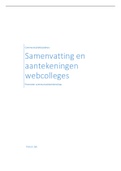Samenvatting
Samenvatting Communicatieklassiekers (S_CK)
- Instelling
- Vrije Universiteit Amsterdam (VU)
COMPLETE SAMENVATTING - Met samenvatting van alle artikelen (22) van alle modules (9) + aantekeningen van alle webcolleges (9)! Sommige artikelen waren gescand, dus daarvan zijn de belangrijkste stukken als afbeelding toegevoegd.
[Meer zien]




